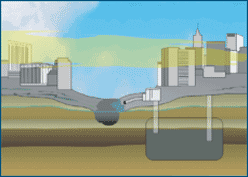Wetland Restoration
Introduction
EPA researchers have collaborated with the State of Delaware and the U.S. Department of Agriculture’s Natural Resources Conservation Service to evaluate the impact of wetland restoration on water quality and wildlife habitat. It is estimated that 90 percent of Delaware’s streams and riparian habitat have been degraded due to activities, such as agriculture, road-building, residential and commercial development, and drainage. To address these concerns, an effort has been initiated to restore stream corridor habitats in order to return highly disturbed or degraded streams and their riparian areas to natural, stable stream channels with high ecological functionality. Specific objectives include:
A recent project at Haines Farm in Delaware focused on using a geomorphic approach to convert a straight, steep-sided ditch with minimal vegetation that exhibited rapid water discharge to a more sinuous, meandering waterway with a wider, naturally vegetated floodplain that exhibited reduced water discharge. As part of the restoration and to improve stream water quality, many small wetlands were created along the restored stream channel within the riparian buffer zone in order to facilitate nutrient uptake and sediment trapping from agricultural runoff. Restoration of the straightened ditch configuration to a natural, more sinuous, stream channel also helped to slow water flow and increase the interaction of runoff waters with vegetation in the adjacent restored floodplain. Wildlife benefits from both wetland and stream restoration actions included enhancement of habitats for feeding, nesting, reproduction, loafing/resting, and protection from predators. Opportunities for ecologically focused wetland restoration exist in areas of agricultural fields that are difficult to till or harvest, such as a point or corner, and consist of marginally productive, poorly drained soils. Historically, most poorly drained portions of fields were forested wetlands. The re establishment of wetlands in these areas results in ecological benefits which include creation of wildlife habitat, increased biodiversity, and reduction in the rate at which storm water runoff is discharged to contiguous streams. The reduction in water volume and nutrients represent measurable indicators that can be used to demonstrate improvements in water quality and overall stream character. References and ProductsWetlands and Water Quality Trading: Review of Current Science and Economic Practices With Selected Case Studies (PDF) (217 pp, 3.01 MB) (EPA/600/R-06/155) July 2007 | Abstract Fate and Effects of Nitrogen and Phosphorus in Shallow Vegetated Aquatic Ecosystems (PDF) (177 pp, 14.1 MB) (EPA/600/R-06/058) June 2006 | Abstract ContactTim Canfield
You will need Adobe Reader to view some of the files on this page. |
![[logo] US EPA](../gif/logo_epaseal.gif)
